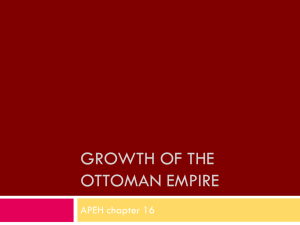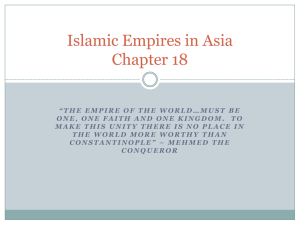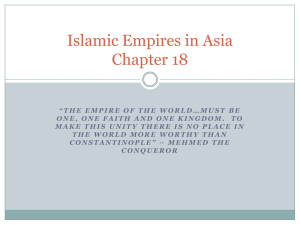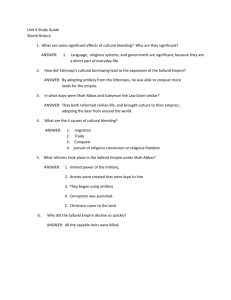Islamic Empires in Asia Chapter 18
advertisement
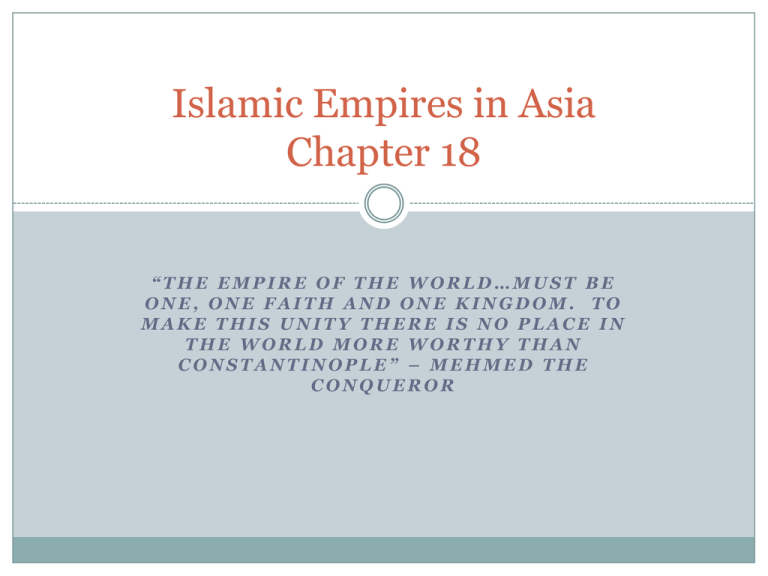
Islamic Empires in Asia Chapter 18 “THE EMPIRE OF THE WORLD…MUST BE ONE, ONE FAITH AND ONE KINGDOM. TO MAKE THIS UNITY THERE IS NO PLACE IN THE WORLD MORE WORTHY THAN CONSTANTINOPLE” – MEHMED THE CONQUEROR Ottoman Empire Rise of the Ottomans Ghazis – Warriors for Islam Anatolia (Modern Day Turkey) Osman – the Ottomans Devshirme Drafted boys from conquered Christian territories. The army educated them, converted them to Islam, and trained them as soldiers. Army Elite – Janissaries War captives & Christian Slaves Converted to Islam Belonged to Sultan Timur – Timur the Lame Restoration of Mongol Empire Military genius & tactician Won a major battle against Ottoman forces Slowed Ottoman advance "Till the advent of Hitler, Timur stood forth in history as the supreme example of soulless and unproductive militarism“ – John Saunders Recovery & Expansion Murad II next period of expansion defeated the Venetians, invaded Hungary, and overcame an army of Italian crusaders in the Balkans Mehmed II Took Constantinople in 1453 – renamed Istanbul Opened the city to people various religions and cultures Selim Persia, Syria, Palestine, North Africa. Mecca, Medina, and Cairo The Greatest Sultan Suleyman West (Europe) – “The Magnificent” East (Own) – “The Lawgiver” Reconstructed legal system Apex of Ottoman military, economic, political power Captured most of Hungary Island of Rhodes, Austria, North Africa Millet System Millets Separate legal courts for communities to rule under “personal law” Protected religious minority groups Own laws & customs – collected taxes Muslims: ethnicity did not matter Orthodox Christians: included all orthodox sects Armenians: Apostolic, Catholic & Evangelical groups Syriac Orthodox – Oriental Orthodox – asked to be separated from Orthodox Christians Jews Decline of an Empire Death of Suleyman – beginning of the end Rise of European states – France, Spain & Poland Decline in 1600’s – 1700’s End of Silk Road Internal power struggles led to corruption Janissaries rebelled 1700’s: Crimean Peninsula (Black Sea Lands) to the Russians 1798: France takes Egypt Restructuring failed by Sultans 1923 – Turkey established as a Republic – End of the Empire End of the Silk Road Safavid Empire Safavid Empire Current Day Iran Safavids were Shi’ite Surrounded by other empires Isma’il: Iran and most of Iraq under his control 1501 Tabriz – made capital Shah – “King” Forced conquered peoples to convert to Shi’a or die Shah Abbas the Great Shah Abbas “the Great” Reformed military using Ottoman model Regained northeastern Persia from Uzbeks Height of an Empire Moved capital to Esfahan – Iranian Plateau Created a flourishing city Improved manufacturing and foreign trade carpet weaving, ceramics Empire began a decline after Abbas’ death – ended 1736 Mughal Empire in India Origins Rajputs Babur Who: Indian warrior princes Mongol leader (Timur) What: Weakened power of sultans Attacked Sultanate of Delhi When: 1500s 1526 Where: Delhi Panipat Why: Gain Power Build an Empire How: Challenged Delhi Sultans Defeated Sultan in Battle Akbar – Greatest of the Mughal Gained support by including the Rajputs in government Improved tax system – created by a Hindu official Supported arts Religious Policy Tolerant of all religions Repealed non-Muslim tax Height of the Empire Shah Jahan Controlled North & Southern India Vigorous ruler – put down rebellions – Delhi new capital Best known for Taj Mahal & Hall of Private Audience Taj Mahal – tomb for Jahan’s wife Hall of Private Audience – Jahan’s palace B/c of economic burden for construction & maintaining the army taxes were raised Sikh Tried to unite Muslim & Hindu philosophies Recognize themselves as a distinct religion not a branch of either One God, no idols, less rigid social system Originally peaceful, did militarize in 1600s Conflict with Shah Jahan regarding his son Aurangzeb 1657 – Aurangzeb takes power Jahan becomes ill – Aurangzeb kills older brother, imprisons Jahan – becomes emperor Devout Sunni – ended government spending on buildings & monuments Persecuted all non Sunni Restored tax on Hindu’s – destroyed Temples Taj Mahal & Hall of Private Audience
